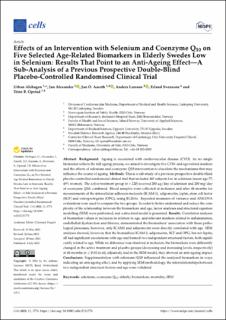Effects of an Intervention with Selenium and Coenzyme Q<inf>10</inf> on Five Selected Age-Related Biomarkers in Elderly Swedes Low in Selenium: Results That Point to an Anti-Ageing Effect—A Sub-Analysis of a Previous Prospective Double-Blind Placebo-Controlled Randomised Clinical Trial
Peer reviewed, Journal article
Published version
Permanent lenke
https://hdl.handle.net/11250/3109980Utgivelsesdato
2023Metadata
Vis full innførselSamlinger
Sammendrag
Background: Ageing is associated with cardiovascular disease (CVD). As no single biomarker reflects the full ageing process, we aimed to investigate five CVD- and age-related markers and the effects of selenium and coenzyme Q10 intervention to elucidate the mechanisms that may influence the course of ageing. Methods: This is a sub-study of a previous prospective double-blind placebo-controlled randomized clinical trial that included 441 subjects low in selenium (mean age 77, 49% women). The active treatment group (n = 220) received 200 µg/day of selenium and 200 mg/day of coenzyme Q10, combined. Blood samples were collected at inclusion and after 48 months for measurements of the intercellular adhesion molecule (ICAM-1), adiponectin, leptin, stem cell factor (SCF) and osteoprotegerin (OPG), using ELISAs. Repeated measures of variance and ANCOVA evaluations were used to compare the two groups. In order to better understand and reduce the complexity of the relationship between the biomarkers and age, factor analyses and structural equation modelling (SEM) were performed, and a structural model is presented. Results: Correlation analyses of biomarker values at inclusion in relation to age, and relevant markers related to inflammation, endothelial dysfunction and fibrosis, demonstrated the biomarkers' association with these pathological processes; however, only ICAM1 and adiponectin were directly correlated with age. SEM analyses showed, however, that the biomarkers ICAM-1, adiponectin, SCF and OPG, but not leptin, all had significant associations with age and formed two independent structural factors, both significantly related to age. While no difference was observed at inclusion, the biomarkers were differently changed in the active treatment and placebo groups (decreasing and increasing levels, respectively) at 48 months (p ≤ 0.02 in all, adjusted), and in the SEM model, they showed an anti-ageing impact. Conclusions: Supplementation with selenium/Q10 influenced the analysed biomarkers in ways indicating an anti-ageing effect, and by applying SEM methodology, the interrelationships between two independent structural factors and age were validated.

